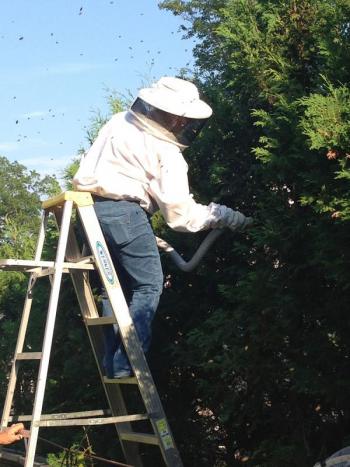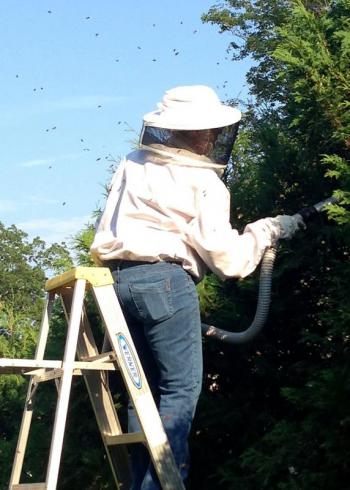Honeybee swarm catching, I’m adding that to my resume
CAMDEN — It's not a big secret this year that honeybees and beekeepers are having a tough time. Many beekeepers this spring found their overwintered hives dead and inconsistent warm, dry weather this summer has caused bees to starve from both a lack of foraging time and blooming flowers to forage from.
This week's heat wave is pushing honeybees to swarm, which is their natural means of reproduction of the colony. When a colony feels it's gotten too big for its current home, or there is a nectar flow and plenty of food, the worker bees will decide the time is right to divide the colony and swarm.
They'll begin to make a new queen from existing larvae and scouts will start looking for a new home. Since the swarm, which will consist of about 60 percent of the current hive population, intends to take the existing queen with them, they'll chase her around and stop feeding her so she'll lose weight and be able to fly with them. The queen, being long and often bulky with shorter wings, is not a good flyer when she's in prime egg-laying mode.
Swarming usually happens in the spring, but it's not uncommon for honeybees to swarm in late summer when there's a stretch of hot, humid weather. When all these factors come together, the departing members of the colony begin to fly out of the hive en masse. Since a strong hive consists of around 60,000 bees, that puts the number of bees in a strong swarm at around 36,000.
My husband, Dave, and I are new beekeepers this year. We went to bee school and became members of the Knox Lincoln County Beekeepers beginning in February. May 28 we officially became beekeepers, picking up two colonies of bees that have challenged us all summer. One hive has always been larger and stronger than the other, and we have done a lot of research and asked a lot of questions to understand how to help them become as strong and healthy as possible in preparation for their first Maine winter.
We have had to requeen a hive and move brood (eggs and larvae) from the bigger hive to the smaller hive to help them keep pace. Spring, summer and fall, honeybees have two main jobs: Grow more bees and store enough honey to keep the colony fed during the winter, when they are stuck inside the hive.
Unlike other insects, honeybees do not hibernate or otherwise go dormant. They spend the winter huddled together as a group, inside either the natural or manmade space they call home. And the energy they expend keeping warm is replaced by their honey reserves.
During our weekly inspection of the hives last Sunday, we noticed the smaller hive had built a few swarm queen cells, and one of them was capped shut. We learned that once a new queen cell is capped, the hive is ready to swarm – probably that day. We took some preventative measures to try and prevent them from swarming, but one of our mentors told us we were simply buying time. If the hive wants to swarm, it's going to swarm, no matter how hard you try to prevent it.
We tried anyway, plugging up all the openings and trapping the queen inside. Three days later, with the weather getting hotter and more humid, we feared the hive was stifling and decided to try and manually split the colony by moving several thousand bees into another hive box we had. We figured if we did nothing, we would wonder if we could have done something.
Our neighbors have been great when it comes to our bees. They have welcomed their pollenating of their blueberries and other honeybee-attractive plantings. And so I sent an email to all of them, alerting them to be on the watch for a swarm given what we knew our small hive was up to.
Today, a day after we split the hive, we got the dreaded call. Our next door neighbor said they watched as thousands of bees exited the hive and then spent about 20 minutes circling over the yard. They eventually landed in a cluster in one of the cedar trees between our yards.
Hurrying home to see what I was up against, I found a large swarm of bees about 8-feet off the ground, seemingly wrapped around the trunk of the tree. The primary swarm out of the hive often initially congregates not far from its original home, so if one is lucky enough to see that first trek, there is a good chance it can be captured.
A couple of phone calls later and I determined I was on my own to try and catch the swarm. Some swarms will wait for days to pick a new home, and some swarms will take off within hours. I did not want to take a chance of losing these bees, and I had two choices to catch them. I could knock them off the branch into a box, or I could scoop them up and into a box. Given their choice of location, wrapped around the trunk, it was too thick to cut. Plus, the bees were actually also hanging on the cedar branches, which swayed like waves but were actually more clusters of bees.
It was Dave who suggested I try our wood stove ash vacuum, which we had complained was deficient in its suction strength. This defect might actually be good for the bees, though I had no idea how sucking up bees with any kind of vacuum was going to work and not kill them. When I took it apart to dump out the ashes it still held, I saw it had a canister like a shop vac, which would work well for the next step, which would be to move the bees from the vacuum to the box.
So, armed with the ash vacuum and my bee veil, I climbed the ladder I had set up and turned on the vacuum. It worked! The bees were gently coming off the cedar tree and I just hoped they weren't getting too tossed around inside the canister.
After removing about 75 percent of the swarm, I climbed down off the ladder, moved toward a hive box I had set up, removed the vacuum lid and quickly tipped the canister up, pouring the bees inside. I slid a lid over the top, leaving a 1/2-inch opening and then watched to see what the bees were going to do.
While it could be estimated that this swarm had about 30,000 bees, there was just one queen bee in the mix. And it was the smell of her pheromone that was attracting everyone else to stay together as a unit. If I had managed to suck her up with the cluster I had in the canister, my swarm catching would be considered a success. If not, if she remained with the bees on the cedar tree I didn't get, then within five minutes the entire swarm of bees in the box would fly back out and rejoin her on the tree. And then I would have to make another attempt with the vacuum and hope I would get her on the second try.
Beginner's luck I got the queen on the first time. It seemed like the bees on the box, though they were clustering in a mass on the outside, were being joined by flying bees who landed and then walked over the edge and inside the box. I left them alone for an hour, and when I went back to check if in fact they were staying, I found the tree was absolutely devoid of bees.
Tonight, the bees are in the new box in the back yard, with our other two hives. They will need to be watched closely for a couple of days to see if they abscond from the box and swarm again. If they stay, we'll have to decide whether we build a complete hive for them or blend them back into the small hive.
Decisions, decisions. I wonder if anyone ever considered that beekeeping is like a slow game of chess. Check – your move bees.






































